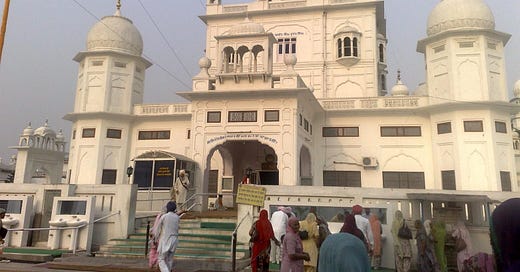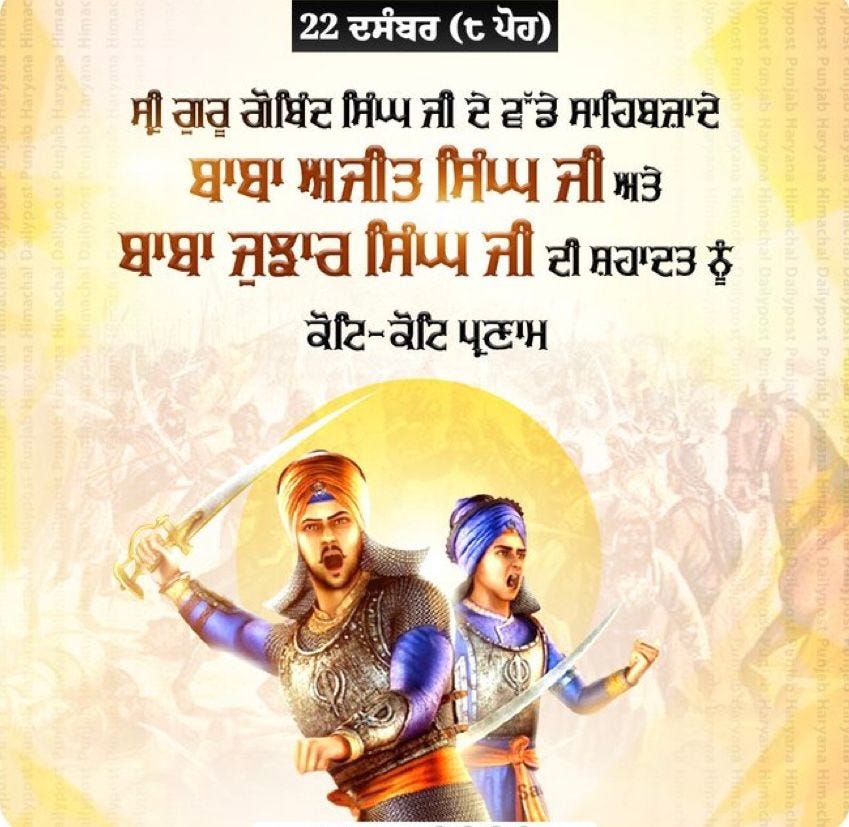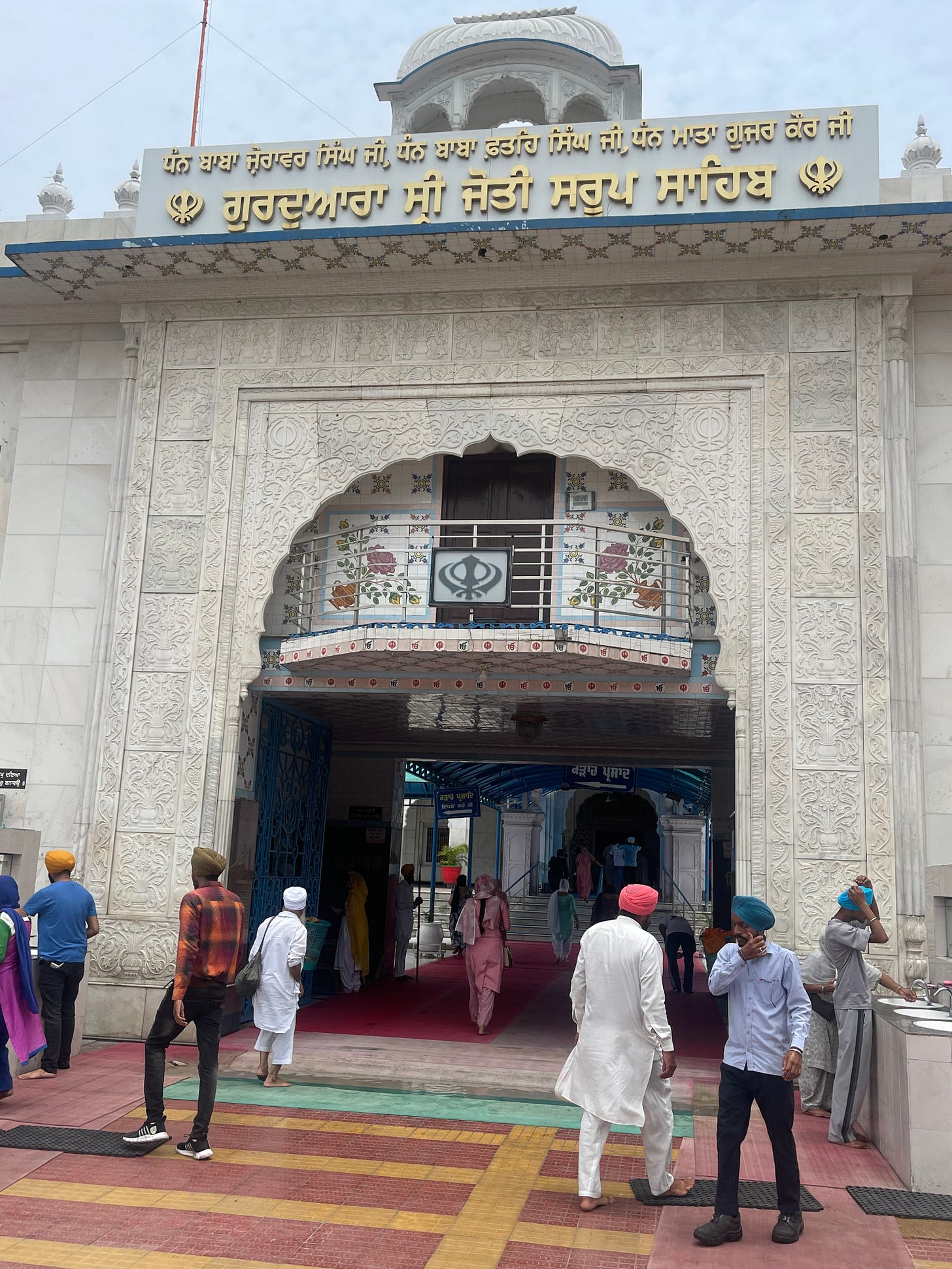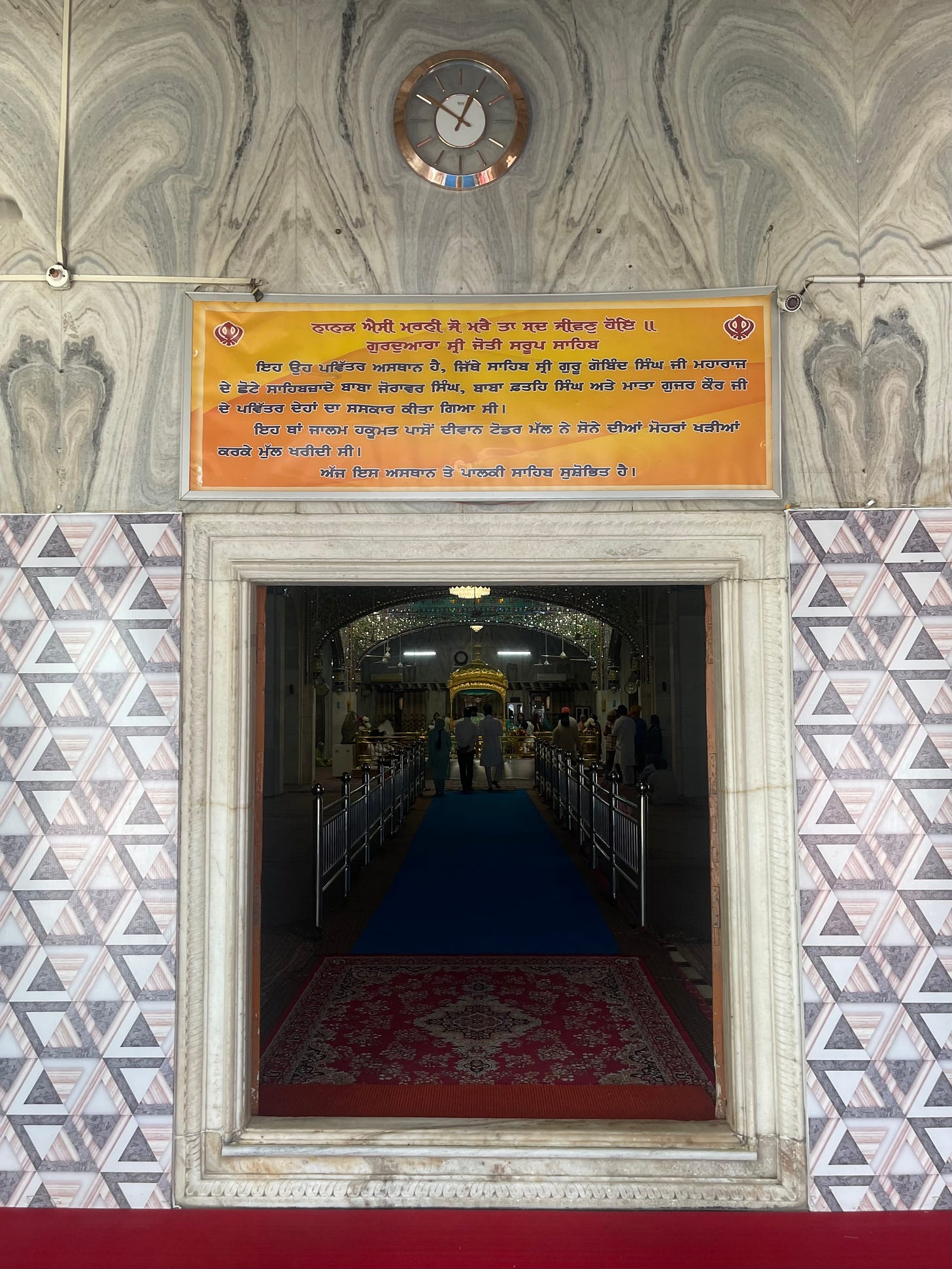Commemorating the Unparalleled Shahadat of Baba Ajit Singh, Baba Jujhar Singh
ਵੱਡੇ ਸਾਹਿਬਜ਼ਾਦਿਆਂ ਬਾਬਾ ਅਜੀਤ ਸਿੰਘ ਤੇ ਬਾਬਾ ਜੁਝਾਰ ਸਿੰਘ ਦੇ ਸ਼ਹੀਦੀ ਦਿਹਾੜੇ 'ਤੇ ਕੋਟਿ ਕੋਟਿ ਪ੍ਰਣਾਮ।
Commemorating the Unparalleled Shahadat of the Elder Sahibzadas
On the solemn occasion of the martyrdom day (Poh 8) of the elder Sahibzadas, Baba Ajit Singh and Baba Jujhar Singh, we bow our heads in eternal reverence to their unparalleled sacrifice at Chamkaur Di Ghari. Blessed by their father, Dashmesh Pita, Sahib Sri Guru Gobind Singh Ji, they, along with forty brave Sikh warriors, valiantly faced an overwhelming enemy to uphold the principles of truth, justice, and righteousness. The courage displayed by these young martyrs and the forty bravehearts, who laid down their lives fighting tyranny, remains an eternal source of inspiration for humanity. Their legacy continues to illuminate the path of steadfast faith and unwavering determination.
ਵੱਡੇ ਸਾਹਿਬਜ਼ਾਦਿਆਂ ਬਾਬਾ ਅਜੀਤ ਸਿੰਘ ਤੇ ਬਾਬਾ ਜੁਝਾਰ ਸਿੰਘ ਦੇ ਸ਼ਹੀਦੀ ਦਿਹਾੜੇ 'ਤੇ ਕੋਟਿ ਕੋਟਿ ਪ੍ਰਣਾਮ।
The Sacred Month of Poh: A Solemn Commemoration
The month of Poh, the tenth in the Nanakshahi calendar, is one of profound solemnity and deep emotional resonance for Sikhs worldwide. Beginning this year on December 14, 2024, and lasting until January 12, 2025, Poh coincides with the cold embrace of winter (Sisiar), yet its days are imbued with an even greater chill—a collective grief and remembrance of sacrifices unparalleled in human history. This sacred month is a time to honour the legacy of the four Sahibzadas, Mata Gujri Ji, and countless Sikhs—both men and women—who stood steadfast in their faith amidst immense adversity, choosing martyrdom over compromise.
The first half of Poh, in particular, carries an overwhelming sense of mourning, as the Sikh community across the globe reflects on these monumental acts of courage and devotion. Unlike other months, the Sangrand of Poh is marked not with greetings or celebrations but with solemn silence and heartfelt introspection. It is a time to grieve, to commemorate, and to draw strength from the sacrifices that forever shaped Sikh history and identity.
Early Poh – The Beginning of Adversity
On 6 Poh (December 21, 1704), Guru Gobind Singh Ji made an immensely challenging decision to leave the fortified city of Anandpur Sahib, the birthplace of the Khalsa (April 13, 1699). This decision was influenced by solemn assurances from the Mughal rulers, who swore upon the Holy Quran to provide safe passage to the Guru, his family, and his followers. However, this promise of safety was laced with betrayal. The departure, undertaken under siege and treachery, marked the beginning of one of the most gruelling and transformative chapters in Sikh history. It set the stage for unparalleled acts of valour, sacrifice, and spiritual resilience that remain eternally etched in the Sikh collective memory.
The Days of Ultimate Sacrifice
On 7 Poh (December 22), Mata Gujri Ji, mother of Gru Gobind Singh ji, and the younger Sahibzadas—Baba Zorawar Singh and Baba Fateh Singh—became separated from the main group at the Sirsa River. This separation led to a chain of events that would culminate in their martyrdom.
Chronological Order of Events: The Battle of Chamkaur
December 21, 1704 (6 Poh)
Arrival at Chamkaur: Guru Gobind Singh Ji and his followers reached the Kachi Garhi (mud fortress) in Chamkaur after leaving Anandpur Sahib.
Preparations began for a defence against the pursuing Mughal forces.
December 22, 1704 (7 Poh)
Siege Begins: The Mughal forces laid siege to the fortress, launching the first major assault.
The Sikhs valiantly repelled the attacks, demonstrating unwavering courage despite being vastly outnumbered.
During the night, Guru Gobind Singh Ji, following the Hukamnama of the remaining Sikhs, prepared to leave the fortress to ensure the survival of the Khalsa mission.
December 23, 1704 (8 Poh)
Final Day of Battle:
The elder Sahibzadas, Baba Ajit Singh (18 years) and Baba Jujhar Singh (14 years), heroically charged into battle and attained martyrdom.
Three of the original Panj Pyare—Bhai Mohkam Singh, Bhai Himmat Singh, and Bhai Sahib Singh—also achieved martyrdom while fighting alongside the Sahibzadas.
Guru Gobind Singh Ji left the fortress under the cover of night, accompanied by Bhai Daya Singh and Bhai Dharam Singh, remaining two of the original Panj Pyare, who survived the battle.
Last Defenders:
Bhai Sangat Singh, wearing Guru Gobind Singh Ji's attire to confuse the enemy, and Bhai Sant Singh made a final stand and attained martyrdom.
December 24, 1704 (9 Poh)
The Remaining Stand:
The last defenders of Chamkaur continued fighting until their martyrdom, cementing the battle as a legendary display of Sikh valor and resilience.
Key Outcomes of the Battle
The martyrdom of Baba Ajit Singh, Baba Jujhar Singh, and three of the Panj Pyare became symbols of unshakable faith and self-sacrifice.
The last defenders, including Bhai Sangat Singh and Bhai Sant Singh, fought until their final breath, ensuring the enemy could not capture Guru Gobind Singh Ji.
Guru Gobind Singh Ji's escape and survival allowed the continuation of the Sikh mission, a turning point in Sikh history.
The battle exemplified the indomitable spirit of the Khalsa, inspiring generations to uphold righteousness and resilience in the face of adversity.
The Unparalled Sacrifices at Sirhind: A Saga of Resilience
On 10 Poh (December 25, 1704), the stage was set for one of the darkest and most heartrending chapters in Sikh history at Sirhind. The younger Sahibzadas—Baba Zorawar Singh (9 years old) and Baba Fateh Singh (7 years old)—along with their revered grandmother, Mata Gujri Ji, were captured and confined in the icy Thanda Burj (Cold Tower) under the orders of Wazir Khan, the ruthless Faujdar of Sirhind. Despite their tender ages and the freezing conditions, the young Sahibzadas demonstrated extraordinary spiritual fortitude. They stood unwavering in their faith, resisting relentless efforts by the Mughal authorities to alternately coerce, entice, and intimidate them into renouncing their beliefs. Their resilience in the face of such inhumanity became a beacon of courage and devotion that continues to inspire the Sikh community and humanity at large.
The Pinnacle of Sacrifice
The ultimate test of their resolve came on 11-12 Poh (December 26, 1704). The young Sahibzadas were presented with the choice of converting to Islam or facing execution. Without hesitation, they chose martyrdom, refusing to abandon the principles of their faith. The chilling walls of the Thanda Burj became silent witnesses to their unyielding courage as they embraced death with grace and devotion, inspiring countless generations to come.
On 13 Poh (December 27, 1704), the saga of sacrifice reached its poignant conclusion. Mata Gujri Ji, having endured the anguish of witnessing the martyrdom of her beloved grandsons, transcended this earthly realm. Despite her profound sorrow, her unwavering faith illuminated the path of righteousness for Sikhs across time. The sacrifices at Sirhind symbolize the zenith of spiritual resilience and moral fortitude, underscoring the enduring legacy of the Khalsa's commitment to truth and justice.
Transition: The Spiritual Solace of Poh
While the month of Poh marks the cruellest period in the earthly journey of Guru Gobind Singh Ji, it is also imbued with profound spiritual solace, as earlier articulated by Guru Arjan Dev Ji in the Bārah Māhā (ਬਾਰਹ ਮਾਹਾ). This sacred composition, enshrined in the Guru Granth Sahib (Ang 133 to 133), transforms Poh into a time of divine warmth amidst the harsh coldness of worldly suffering. The verses of Poh reflect the yearning of the soul-bride for union with the Divine, offering Sikhs a path to transcend sorrow and find strength in their faith.
Just as the first half of Poh draws the Sikh community into mourning and remembrance of the supreme sacrifices, the second half becomes a time for renewal, including the birthday celebration of Sri Guru Gobind Singh ji, taking us the threshold of the month of Magh, starting with festival of Maghi. The spiritual themes of Poh, woven into the Bārah Māhā, inspire Sikhs to recover from their grief and carry on their lives and sewa (selfless service) with renewed vigour. This duality of mourning and resilience in Poh encapsulates the essence of the Sikh spirit—drawing solace from divine teachings and moving forward with unwavering commitment to righteousness.
The Verses for Poh in the Bārah Māhā
The following verses from the Bārah Māhā reflect the spiritual essence of Poh:
ਪੋਖਿ ਤੁਖਾਰੁ ਨ ਵਿਆਪਈ ਕੰਠਿ ਮਿਲਿਆ ਹਰਿ ਨਾਹੁ ॥
(In the month of Poh, the cold does not touch those whom the Husband Lord embraces.)
ਮਨੁ ਬੇਧਿਆ ਚਰਨਾਰਬਿੰਦ ਦਰਸਨਿ ਲਗੜਾ ਸਾਹੁ ॥
(Their minds are transfixed by His Lotus Feet. They are attached to the Blessed Vision of the Lord's Darshan.)
ਓਟ ਗੋਵਿੰਦ ਗੋਪਾਲ ਰਾਇ ਸੇਵਾ ਸੁਆਮੀ ਲਾਹੁ ॥
(Seek the Protection of the Lord of the Universe; His service is truly profitable.)
ਬਿਖਿਆ ਪੋਹਿ ਨ ਸਕਈ ਮਿਲਿ ਸਾਧੂ ਗੁਣ ਗਾਹੁ ॥
(Corruption shall not touch you when you join the Holy Saints and sing the Lord's Praises.)
ਜਹ ਤੇ ਉਪਜੀ ਤਹ ਮਿਲੀ ਸਚੀ ਪ੍ਰੀਤਿ ਸਮਾਹੁ ॥
(From where it originated, there the soul is blended again. It is absorbed in the Love of the True Lord.)
ਕਰੁ ਗਹਿ ਲੀਨੀ ਪਾਰਬ੍ਰਹਮਿ ਬਹੁੜਿ ਨ ਵਿਛੁੜੀਆਹੁ ॥
(When the Supreme Lord God grasps someone's hand, they shall never again suffer separation from Him.)
ਬਾਰਿ ਜਾਉ ਲਖ ਬੇਰੀਆ ਹਰਿ ਸਜਣੁ ਅਗਮ ਅਗਾਹੁ ॥
(I am a sacrifice a lakh times, to the Lord, my Friend, the Unapproachable and Unfathomable.)
ਸਰਮ ਪਈ ਨਾਰਾਇਣੈ ਨਾਨਕ ਦਰਿ ਪਈਆਹੁ ॥
(Please preserve my honor, Lord Almighty; Nanak beseeches at Your Door.)
ਪੋਖੁ ਸੋੁਹੰਦਾ ਸਰਬ ਸੁਖ ਜਿਸੁ ਬਖਸੇ ਵੇਪਰਵਾਹੁ ॥੧੧॥
(Poh is beautiful, and all comforts come to the one whom the Carefree Lord has forgiven. ||11||)
The Final Chapter: A Legacy of Sacrifice and the Path Forward
The month of Poh is a time of profound emotional commemoration for Sikhs worldwide. It is a sacred period to honour the unparalleled sacrifices of the younger Sahibzadas, Baba Zorawar Singh and Baba Fateh Singh, their elder brothers Baba Ajit Singh and Baba Jujhar Singh, and their grandmother Mata Gujri Ji, whose steadfast faith and courage continue to illuminate the path of righteousness. Their martyrdom epitomizes the pinnacle of devotion, unyielding courage, and unwavering faith, inspiring generations to uphold the ideals of truth and justice. As Sikhs immerse themselves in these solemn remembrances, the teachings of the Bārah Māhā, with their emphasis on divine grace, provide solace, reminding us that even in the harshest winters of life, spiritual warmth can triumph over worldly suffering.
Yet, Poh is not merely a time to grieve—it is a call to action. In the bitter chill of winter, the sacrifices remembered during Poh reignite the flame of the Sikh spirit, urging the community to move forward with renewed vigor and purpose. The Guru’s teachings call upon us to embody the values of sewa (selfless service) and sarbat da bhala (the well-being of all). As Guru Gobind Singh Ji so beautifully taught, “Manas ki jaat sabhi ekai pehchaanbo”(ਮਾਨਸ ਕੀ ਜਾਤ ਸਬੈ ਏਕੈ ਪਹਚਾਨਬੋ)—recognize all of humanity as one. This universal message transcends the boundaries of religion, caste, and creed, inspiring us to build a world grounded in equality, compassion, and justice.
Carrying Forward the Legacy of Courage and Compassion
The month of Poh, with its sacred legacy of supreme sacrifices, stands as a spiritual beacon that illuminates our path, not merely commemorating the past but inspiring us to act in the present with renewed faith and purpose. On the martyrdom day (Poh 8) of the elder Sahibzadas, Baba Ajit Singh and Baba Jujhar Singh, this month reminds us of their unmatched valor and unwavering commitment to righteousness, urging us to rise above fear and self-interest in the service of humanity. It calls upon us to see every moment as an opportunity to walk closer to the Divine, to uphold the eternal principles of the Khalsa, and to dedicate ourselves to truth, justice, and compassion. Let this solemn remembrance transform our mourning into a powerful resolve—one that propels us to follow the Guru’s path with steadfast dedication, embodying love, humility, and courage in our everyday lives.
26th December - A Solemn Remembrance: Gurudwara Jyoti Saroop and the Saga of Unparalleled Sacrifice at Fatehgarh Sahib
Gurudwara Jyoti Saroop, complete darshan-video
Banda Singh Bahadur: The Eternal Legacy of Sirhind and Sovereignty – A Birth Anniversary Tribute
Celebrating the Birth Anniversary of Banda Singh Bahadur











ਚਮਕੌਰ ਦੀ ਗੜ੍ਹੀ ਵਿੱਚ ਦੁਨੀਆਂ ਦੀ ਅਨੋਖੀ ਅਤੇ ਅਸਾਵੀਂ ਜੰਗ ਹੋਈ ਜਿਸ ਵਿੱਚ ਗੁਰੂ ਸਾਹਿਬ ਨਾਲ 40 ਗੁਰਸਿੱਖ ਮਰਜੀਵੜਿਆਂ ਸਾਹਮਣੇ 10 ਲੱਖ ਭੇਡੂਆਂ ਦਾ ਹਜ਼ੂਮ ਸੀ। ਗੁਰੂ ਸਾਹਿਬ ਜੀ ਦੀ ਲੜਾਈ ਕਿਸੇ ਜਾਇਦਾਦ ਜਾਂ ਰਾਜ -ਭਾਗ ਜਾਂ ਔਰਤਾਂ ਪਿੱਛੇ ਨਹੀਂ ਸੀ ਅਤੇ ਨਾਂ ਹੀ ਕਿਸੇ ਧਰਮ ਵਿਰੁੱਧ ਸੀ ਇਸ ਦਾ ਕਾਰਨ ਜ਼ੁਲਮ ਅਤੇ ਜ਼ੁਲਮ ਕਰਨ ਵਾਲੇ ਹਾਕਮਾਂ ਦਾ ਨਾਸ਼ ਕਰਕੇ ਸੱਭ ਨੂੰ ਸਵੈ ਮਾਣ ਅਤੇ ਅਣਖ ਨਾਲ ਜਿਉਣ ਦਾ ਹੱਕ ਦਿਵਾਉਣਾ ਸੀ। ਅੱਜ ਭਾਰਤ ਵਿੱਚ ਵੱਸਣ ਵਾਲੇ ਅਲੱਗ ਅਲੱਗ ਧਰਮਾਂ ਦੇ ਲੋਕਾਂ ਦੀਆਂ ਨਿਸ਼ਾਨੀਆਂ ਇਸੇ ਕਰਕੇ ਜੀਵਤ ਹਨ । ਸਾਹਿਬ ਜੀ ਦੇ ਸਾਹਿਬਜ਼ਾਦਿਆਂ ਦੀ ਯਾਦ ਵਿੱਚ ਝੂਲਦੇ ਨਿਸ਼ਾਨ ਸ਼ੋਭਾ ਪਾ ਰਹੇ ਹਨ ਅਤੇ ਸਨਾਤਨੀ ਟੱਲੀਆਂ ਵਜਾ ਰਹੇ ਹਨ।
ਧੰਨ ਗੁਰੂ ਧੰਨ ਸਿੱਖ ਪਿਆਰੇ
Sir: Reading was like meeting with you at a pilgrimage .
As a school-going kid, I remember learning about Sikh history, especially the significance of the month of Poh—or more broadly, December. Back then, those events felt like distant stories, like chapters from the past, but they were deeply intertwined with the values of courage, sacrifice, and devotion that we still uphold today. The Poh month wasn’t just a marker of time; it felt like a living part of our tradition.
The martyrdom of Guru Tegh Bahadur on Poh 11 was particularly poignant. At the time, reading about his supreme sacrifice for religious freedom left a deep impression on me. It wasn’t just a historical fact—it was a call to understand the strength of conviction and the cost of standing up for what is right, even in the face of immense personal loss. As a child, I was deeply moved by how his sacrifice resonated not only in the history of Sikhism but in the very fabric of who we are as a community.
In those early years of studying Sikh history, I found myself embracing these stories—not as distant tales from the past, but as part of an ongoing legacy. Each event, from the birth of Guru Gobind Singh to the martyrdom of Guru Tegh Bahadur, wasn’t just something to memorize—it was a message to live by. As I grew older, I realized that the sacrifices and teachings of these Gurus were meant to shape the way we live our lives today, reminding us of the importance of standing for truth, freedom, and justice, no matter the cost.
Reflecting on Poh now, I see it not just as a month in the calendar, but as a time to reconnect with the deep sacrifices made by our Gurus and to appreciate the resilience and commitment that are at the heart of Sikhism.
Enjoyed reading and appreciate it vastly.